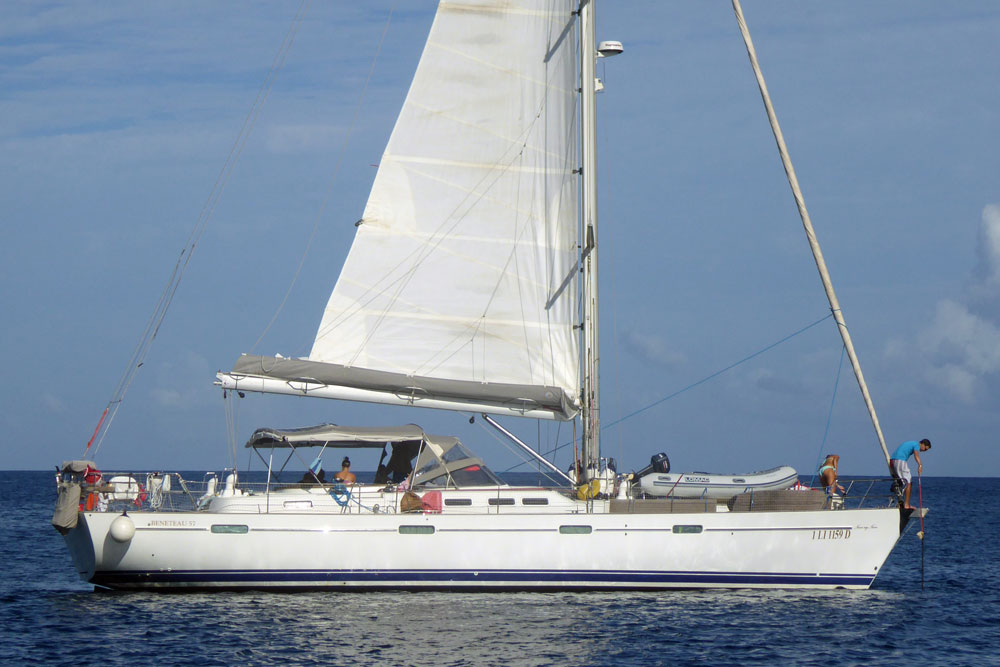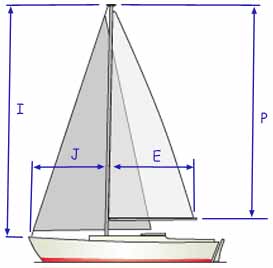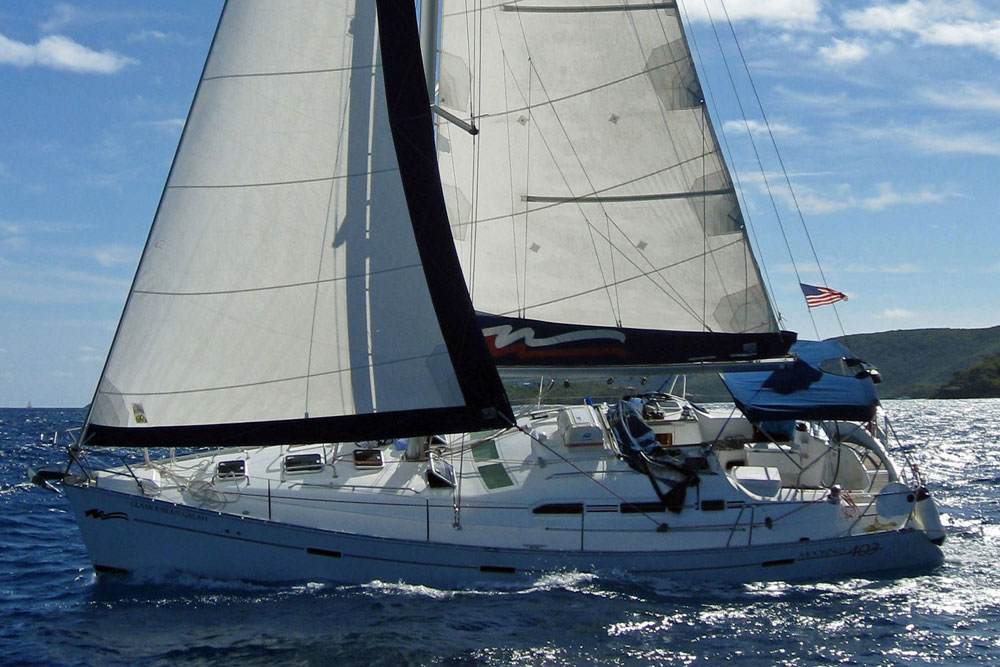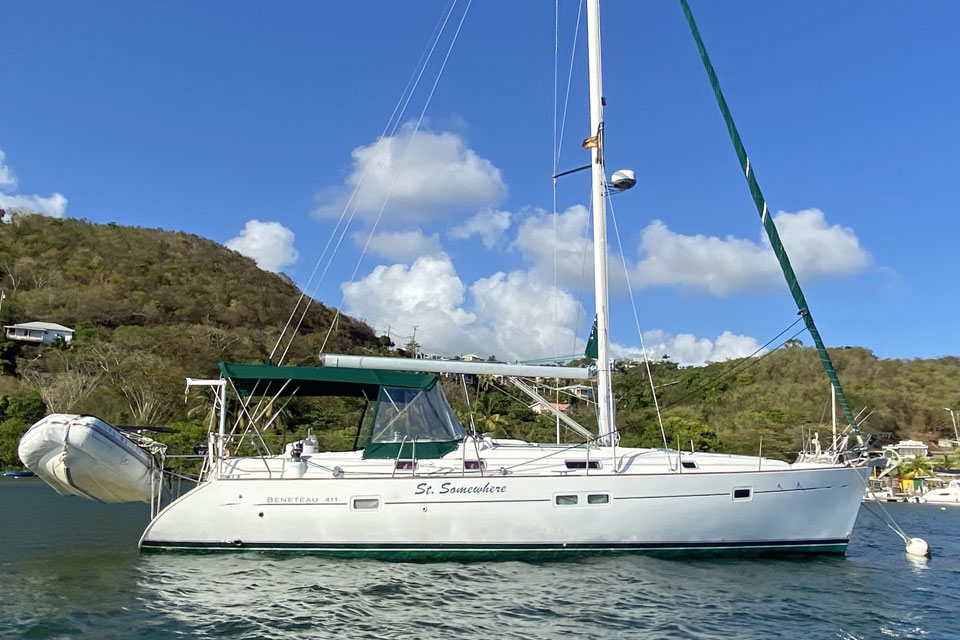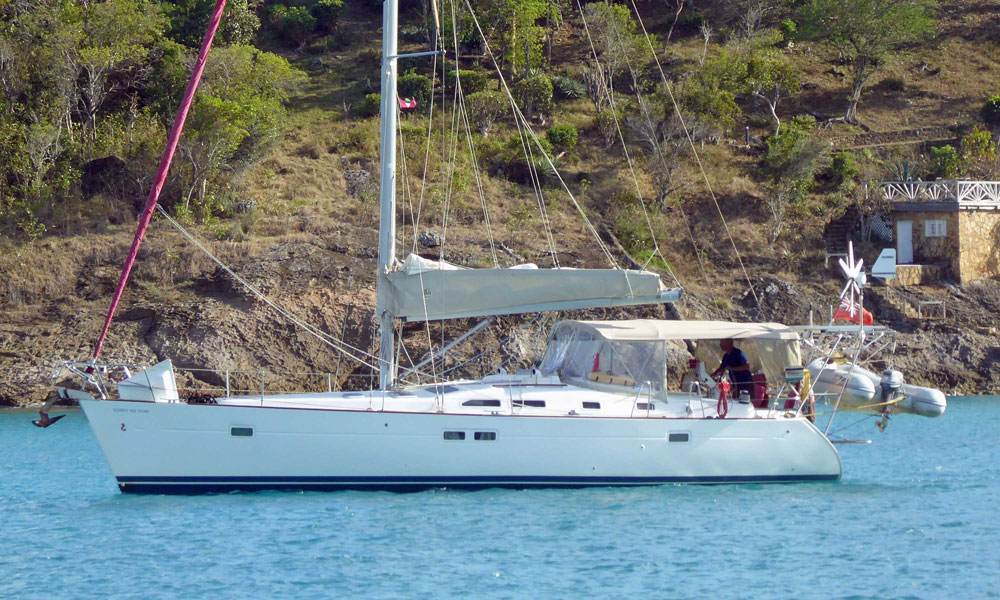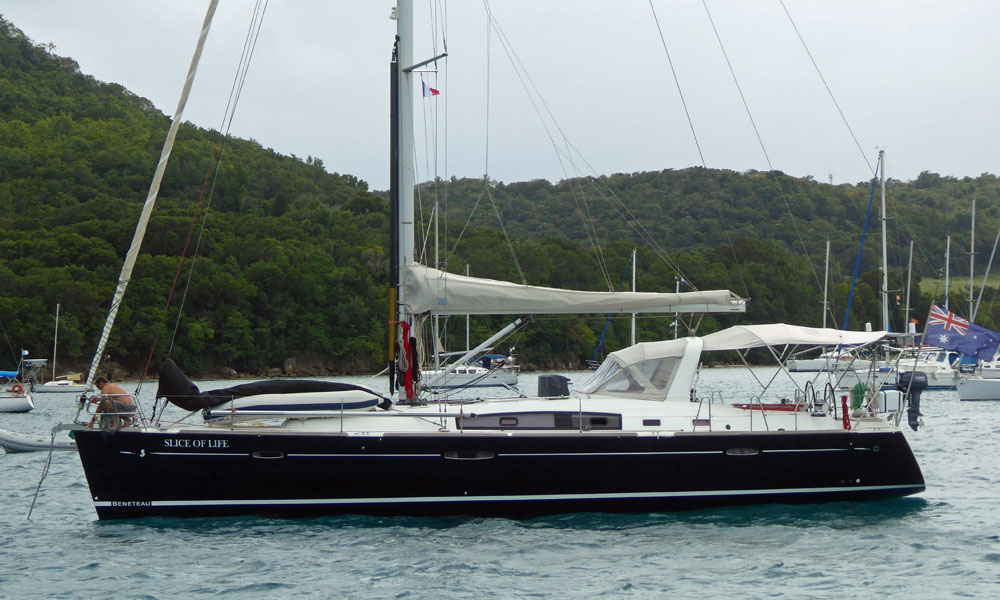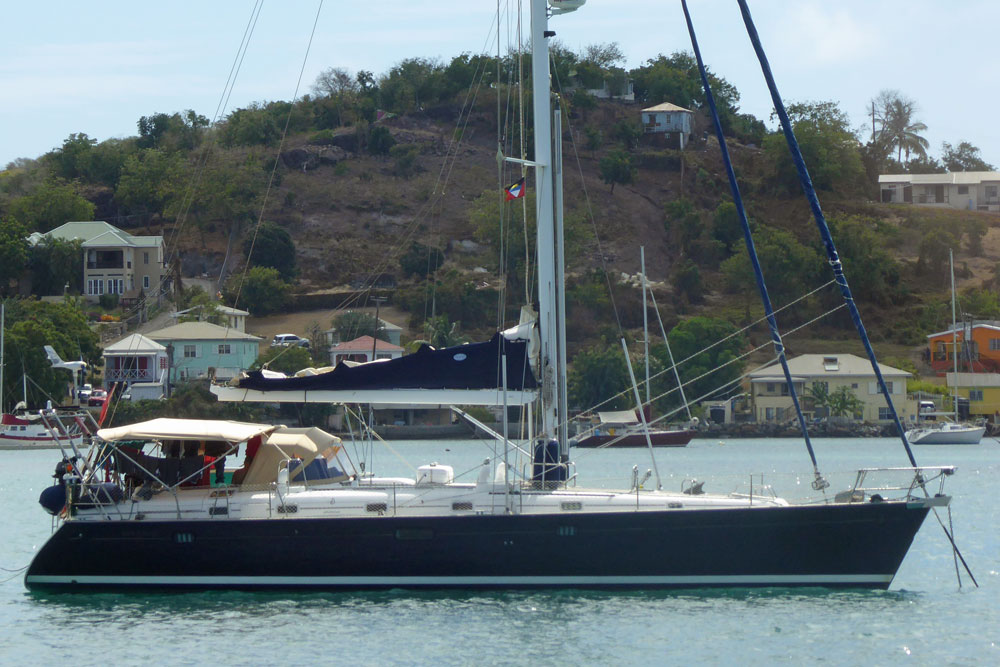- Home
- Cruiser Yachts over 55'
- Beneteau 57
The Beneteau 57 Sailboat
Specs & Key Performance Indicators
The Beneteau 57 is a 58-foot monohull sailboat designed by Bruce Farr and first-built by Beneteau in 2002. She is a fast and comfortable cruiser that can sail long distances with a relatively small crew.
Published Specification for the Beneteau 57
Keel & Rudder Configuration: Bulb fin keel & spade rudder
Hull Material: GRP (Fibreglass)
Length Overall: 57'0" (17.4 m)
Waterline Length: 49'3" (15.0 m)
Beam: 16'4" (5.0 m)
Draft: 8'6" (2.6 m) standard, 6'11" (2.1 m) shoal
Rig Type: Fractional sloop
Displacement: 48,623 lb (22,055 kg)
Ballast: 17,108 lb (7,760 kg)
Water Tank Capacity: 1,000 liters (264 gallons)
Fuel Tank Capacity: 480 liters (127 gallons)
Hull Speed: 11.5 knots
Designer: Bruce Farr
Builder: Beneteau
Year First Built: 2002
Year Last Built: 2010
Options & Alternatives
Buyers of the Beneteau 57 sailboat had several design options to choose from:
Rig Type
- Sloop (Fractional): The standard rig configuration for the Beneteau 57 was a fractional sloop.
- Cutter: Some owners opted for a cutter rig, which includes an additional staysail for improved sail handling and performance in various wind conditions.
Draft
- Deep Draft: The standard draft was 8'6" (2.6 m), providing better upwind performance and stability.
- Shallow Draft: An optional shoal draft version was available with a draft of 6'11" (2.1 m), making it more suitable for cruising in shallower waters.
Interior Layouts
- 3-Cabin Layout: This layout typically included a spacious owner's cabin aft and two guest cabins forward, each with its own en-suite head.
- 4-Cabin Layout: Some versions offered a four-cabin layout, with an additional cabin forward, often used for crew or additional guests.
- Custom Layouts: Beneteau also provided options for semi-custom interiors, allowing buyers to tailor the layout and finishes to their preferences, including choices for wood finishes, upholstery, and additional amenities.
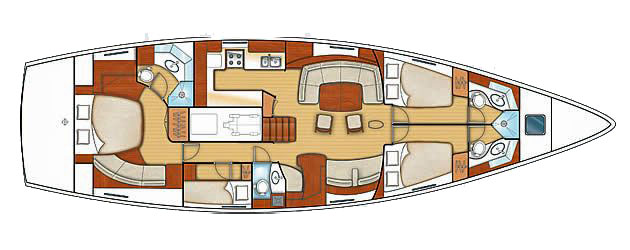 A typical 4-Cabin Layout
A typical 4-Cabin LayoutSail Areas & Rig Dimensions
Sail Areas
- Mainsail Area: 796ft2 (74m²)
- Genoa Area: 845ft2 (78.5m²)
Rig Dimensions
- I: 70'6" (21.5m)
- J: 21'6" (6.6m)
- P: 64'0" (19.5m)
- E: 23'0" (7.0m)
Published Design Ratios
The Key Performance Indicators (KPIs)
Sail Area/Displacement Ratio (SA/D): 20.3
Displacement/Length Ratio (D/L): 182
Ballast/Displacement Ratio: 35%
Comfort Ratio: 35.5
Capsize Screening Formula: 1.8
The following analysis of the primary design ratios gives an indication of the boat's likely sailing characteristics, but see the 'Notes of Caution' that follow below:
- The Sail Area/Displacement Ratio of 20.3 suggests that the Beneteau 57 has a relatively high performance capability. With an SA/D ratio above 20, the boat is expected to be quite powerful and capable of good speed, especially in the right hands. It indicates that the boat can perform well in a variety of wind conditions.
- The Displacement/Length Ratio of 182 places the Beneteau 57 in the light to moderate displacement category. This means the boat requires less sail area to reach its hull speed, making it more efficient and easier to handle in lighter winds. It also suggests a good balance between performance and comfort.
- With a Ballast/Displacement Ratio of 35%, the Beneteau 57 is moderately stiff. While it may not be as stiff as boats with a ratio of 40% or more, it still offers a good level of stability and power to stand up to the wind, providing a comfortable and safe sailing experience.
- The Comfort Ratio of 35.5 indicates that the Beneteau 57 has a reasonably sedate motion, typical of a moderate bluewater cruising boat. This means it should provide a comfortable ride in most conditions, with less pronounced pitch, roll, or corkscrew motion, making it suitable for extended cruising.
- A Capsize Screening Value of 1.8 suggests that the Beneteau 57 is well-suited for ocean passages. This low value indicates a lower risk of capsizing, making the boat a good choice for bluewater sailing and offshore cruising.
Overall, the Beneteau 57 appears to be a well-balanced sailboat with good performance, stability, and comfort, making it suitable for both coastal cruising and longer ocean passages.
Here's how to calculate the KPIs yourself - without having to wrestle with the mathematics...
Design Ratios: Notes of Caution...
- The Sail Area/Displacement Ratio (SA/D): This ratio provides an estimate of the sail power relative to the boat's weight, which can indicate potential speed in various wind conditions. But it doesn't account for the efficiency of the sail plan, the rigging, or the skill of the crew. Real-world performance can vary significantly based on these factors.
- The Ballast/Displacement Ratio (B/D): This ratio gives an idea of the boat's stability and stiffness, which is crucial for handling and safety. But it doesn't consider the distribution of the ballast or the hull shape, both of which can greatly affect stability. A high B/D ratio alone doesn't guarantee a stable boat if the ballast is poorly distributed.
- The Displacement/Length Ratio (D/L): This ratio helps predict the boat's speed potential and its behaviour in different sea conditions. But it doesn't account for the hull design or the boat's overall weight distribution. Two boats with the same D/L ratio can perform very differently if their hull shapes are different.
- The Comfort Ratio (CR): This ratio estimates the boat's motion comfort in a seaway, which is important for long passages. But it doesn't consider the boat's interior layout, which can also affect comfort. Additionally, personal tolerance to motion varies, so a boat that is comfortable for one person might not be for another.
- The Capsize Screening Formula (CSF): This formula assesses the likelihood of a boat capsizing in heavy seas, which is critical for offshore safety. But it doesn't take into account the boat's handling characteristics or the skill of the crew. A boat with a low CSF can still capsize if poorly handled in severe conditions.
General Limitations
- Static Nature: These ratios are static measurements and don't account for dynamic factors like wave action, wind gusts, or crew actions.
- Simplification: They simplify complex interactions into single numbers, which can be misleading. Real-world performance is influenced by a multitude of factors that these ratios can't fully capture.
- Context: The context in which the boat is used (e.g., coastal cruising vs. offshore racing) can greatly affect how these ratios should be interpreted.
In summary, while these ratios provide valuable insights into the theoretical performance characteristics of a sailboat, they should be used as part of a broader assessment that includes practical experience, sea trials, and expert advice.
The above text was drafted by sailboat-cruising.com using GPT-4 (OpenAI’s large-scale language-generation model) as a research assistant to develop source material; we believe it to be accurate to the best of our knowledge.
Other sailboats in the Beneteau product range include:
Recent Articles
-
Is Marine SSB Still Used?
Apr 15, 25 02:05 PM
You'll find the answer to this and other marine SSB-related questions right here... -
Is An SSB Marine Radio Installation Worth Having on Your Sailboat?
Apr 14, 25 02:31 PM
SSB marine radio is expensive to buy and install, but remains the bluewater sailors' favourite means of long-range communication, and here's why -
Correct VHF Radio Procedure: Your Questions Answered
Apr 14, 25 08:37 AM
Got a question about correct VHF radio procedure? Odds are you'll find your answer here...
